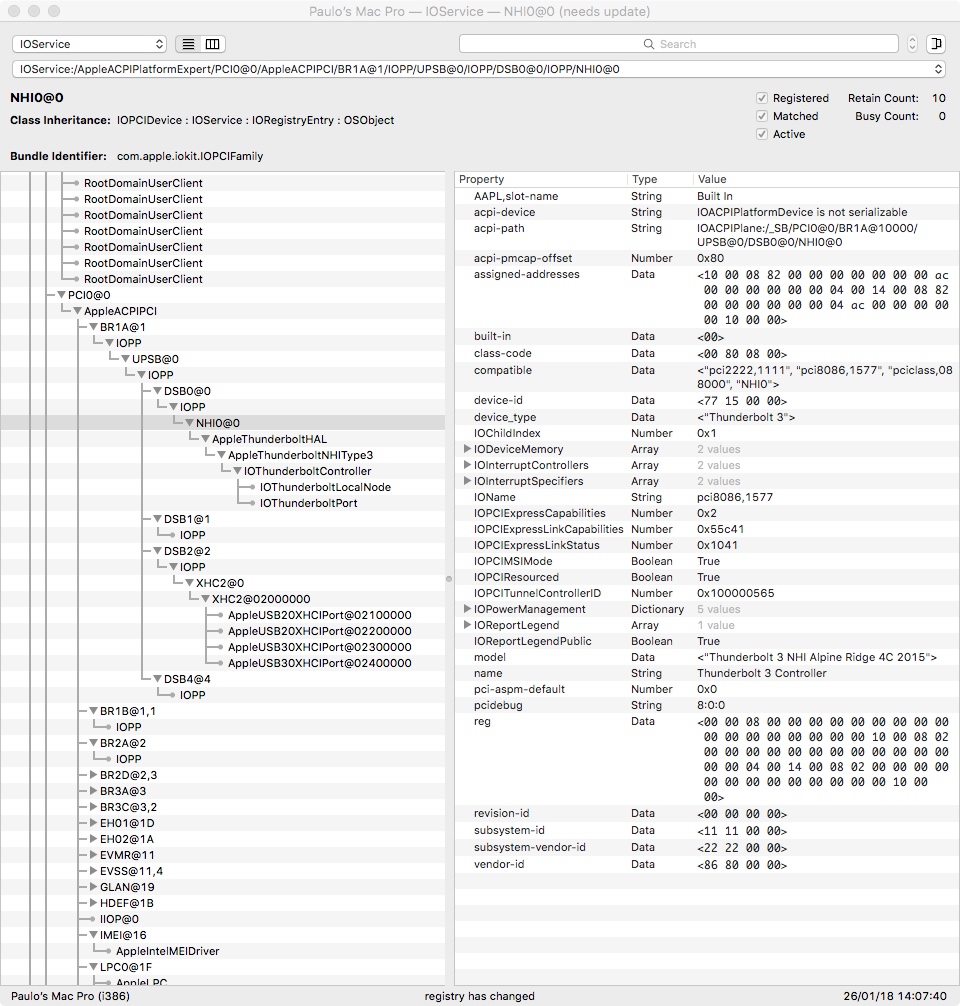
- #APPLE THUNDERBOLT DRIVER ESXI 6.5 INSTALL#
- #APPLE THUNDERBOLT DRIVER ESXI 6.5 DRIVERS#
- #APPLE THUNDERBOLT DRIVER ESXI 6.5 UPDATE#
- #APPLE THUNDERBOLT DRIVER ESXI 6.5 PATCH#
- #APPLE THUNDERBOLT DRIVER ESXI 6.5 SOFTWARE#
Enter the Name and select the Baseline Type. Navigate to the Host Baselines tab and select New Baseline. Next, we will add the pertinent patches to a Baseline. Progress can be monitored in the Recent Tasks pane. Select the newly added Source and click Download Now to download the patches. NOTE – If you don’t have an internet connection, you can manually import the patches from a local. In our case, the HPE repository is located at. In the Add Download Source window, enter the download source URL. Select Add under Direct connection to Internet.

Click the Edit button to add the download source. Click the Manage tab, Download Settings under the Settings tab. Select the vCenter Server under Navigator.
#APPLE THUNDERBOLT DRIVER ESXI 6.5 UPDATE#
To do so, navigate to Update Manager from the vCenter Server Web Client. The easiest way to obtain HPE patches is by downloading them from their online repository. In our next step, we will move to vSphere Update Manager to add and download pertinent patches from the HPE repository. Here we can see this host is running the affected driver iLO driver (650.10.0.1-24).
#APPLE THUNDERBOLT DRIVER ESXI 6.5 SOFTWARE#
Once logged into the host, run the esxcli software vib list command searching for strings matching HP. To begin, enable and initiate an SSH session to the host. In our instance, we will check the ESXi host(s) for the affected HP driver. Resolved by upgrading the hpe-ilo driver to version 650.10.0.2 or later.

VMware ESXi 6.5 host fails with a Purple Screen Diagnostic, indicating that CPU XX / World XXXXXX tried to re-acquire a lock. Issue Background – HPE Advisory regarding Proliant servers deployed using the hpe-ilo driver version 65.10.0.1-24.
#APPLE THUNDERBOLT DRIVER ESXI 6.5 PATCH#
Despite this being a very specific patch, the general patch procedure can be applied to other driver updates as well. That being the case, it seemed fitting to go through the patch process for the affected iLO driver in this post. In a vSphere 6.5 troubleshooting post, we discussed a PSOD issue stemming from a specific HP iLO driver.

#APPLE THUNDERBOLT DRIVER ESXI 6.5 DRIVERS#
I finally was able to encode 10 videos in Handbrake/NVEnc non stop without freezing.Today I wanted to run through the process used to patch HP drivers on an ESXi host specifically through Update Manager. My system is not 100% stable as yet but it's a huge step forward compared to what I did documented here above. SoĬ- change the virtualHW.version to e.g. If at this point you can operate the passwhtough video card but somehow is unstable: downgrade your VM hardware version to something lower than 10. I had luck with link but other people with different system and dfferent GPUs are forced to use different reset values. Accepted values are: d3d0, link, bridge, default Edit your /etc/vmware/passthru.map and modify the bridge keyword into a different value. After further researches I ended up applying 2 additional modifications:Ħ) Since my video card has 8GB of memory as an extension to point 4) above under the VM parameters also add:ħ) If an only if your VM is unstable past this point you can attempt a final step which will require the host reboot. The steps 1 to 5 above helped me to make the card operational but. I had a pre-existing VM in BIOS so didn't want to reinstall so all this procedure refer to BIOS only. NOTE2: Reading up in Internet it seems like pass-through works better with EFI rather than BIOS.

#APPLE THUNDERBOLT DRIVER ESXI 6.5 INSTALL#
Hence remote console is not working but you can install your own remote admin software I suppose. That's when I guess Windows disables the sVGA and set the NVIDIA to be the primary. NOTE: The only negative point since the sVGA is disable in the windows configuration, the ESXi remote console will only show up to the windows loading logo and get stuck there. So forget about device manager and head straight to the Windows Graphic Settings (right click on desktop/Display Settings):Ī) highlight the display linked to the NVIDIA cardĬ) under "multiple displays" select "show only on 2" (in my particular case) Note, vmwaretools will bypass any attempt to disable the internal sVGA or it's virtual display. Leave the default sVGA config untouchedĤ) Modify the parameter of the Windows10 VM adding:ĥ) Once you boot into Windows I first had to make the NVIDIA display act as primary. If you don't do this method below is not going not work ESXi still boots but the progress bar is never to reach the end.Ģ) Enable pass-through on the card (via system management) and rebootģ) assign the card as PCI to the VM and reserve all the RAM you have assigned. State: Normal (not connected to any vCenter Server)ġ) Once you install the GPU make sure the Server BIOS prefers internal video card to any PCIE Without monitor directly connected to the GPU this below is likely not to work. I have however ordered but not received yet a dummy HDMI plug which essentially simulate a monitor connection. I got a traditional 1070 instead and plugged an old monitor via DVI. First of all I had to replace the GTX 1060 as it was a mining card e.g.


 0 kommentar(er)
0 kommentar(er)
